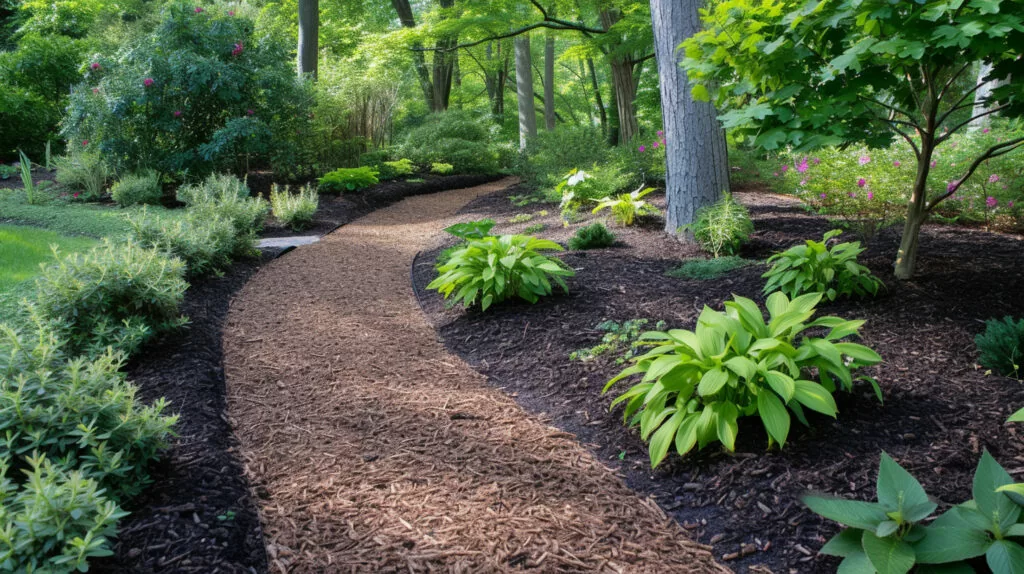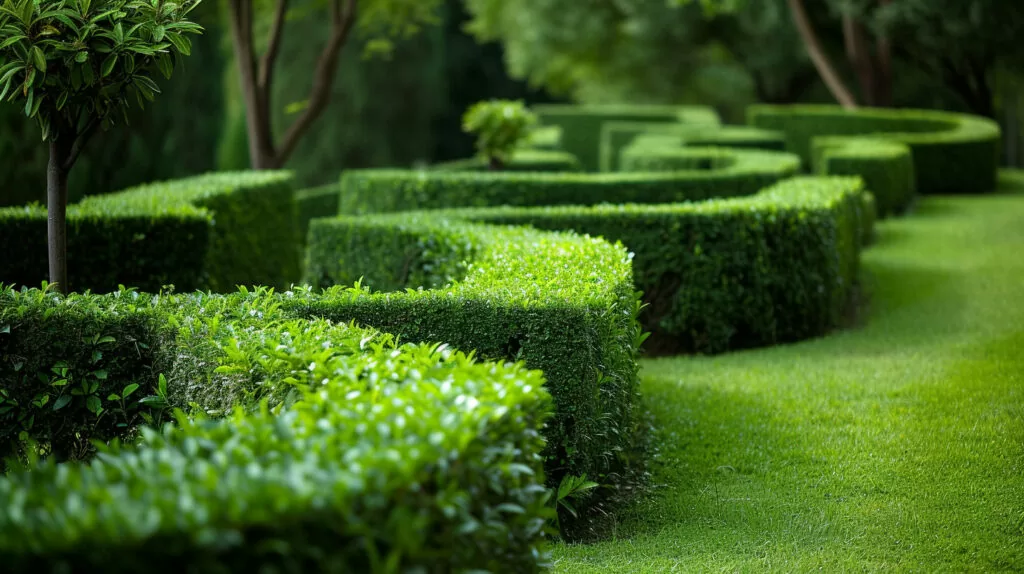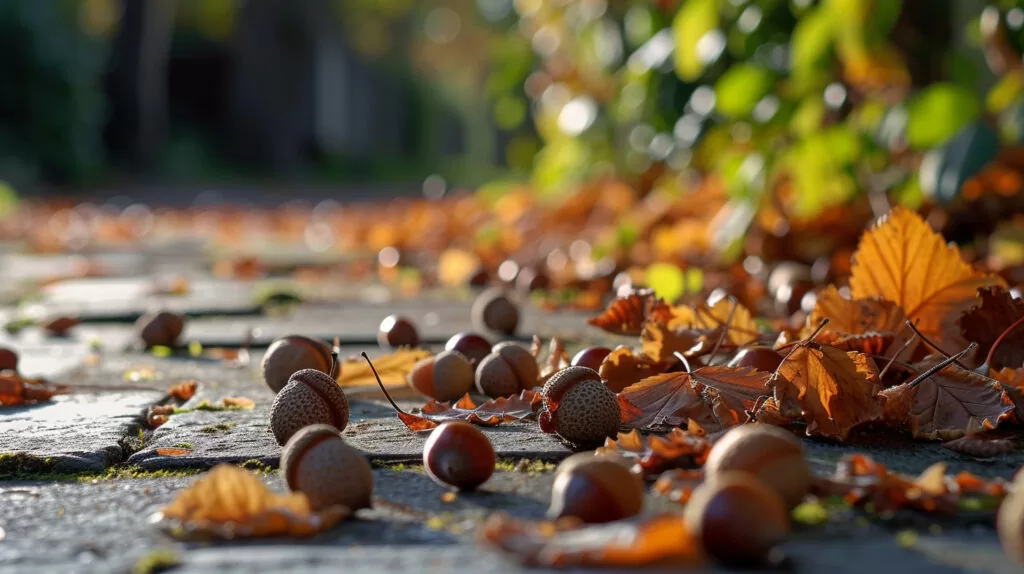The arrival of spring is a time of renewal in the backyard. After a long winter, your outdoor space likely needs some freshening up to restore its beauty and get it ready for sunny days ahead. Tackling a thorough spring cleaning checklist helps ensure your yard will look its best when temperatures warm up.
A proper spring cleaning covers everything from clearing debris to pruning plants, repairing structures, and preparing gardens and lawns. Having a comprehensive checklist makes the process efficient and structured. Below are some key tasks to focus on when doing your spring backyard refresh.
Patio Productions Key Points
- Clear yard debris like leaves, branches, and weeds to start fresh.
- Prune overgrown trees, shrubs, and perennials for shape and growth.
- Deep clean outdoor furniture, power wash surfaces, and inspect fences.
- Organize garden tools and supplies for easy access and plant new flowers.

Clearing Yard Debris
The first step in any spring backyard refresh is debris removal. Take a walk around the property and look for:
- Fallen leaves, twigs, and branches
- Old pots, tools, hoses, and other items that need to go
- Pinecones, acorns, seed pods, and other natural debris
Use a stiff rake to gather up leaves from grassy areas. Remove sticks, rocks, and other objects that could damage lawn mowers. Inspect fences, structures, and trees for broken or dangling branches. Prune these away using proper cutting techniques.
Set aside any usable sticks or branches for starting compost piles or craft projects later. Rake or shovel other debris into yard waste bags for curbside pickup or drop-off at your local waste facility. If you have flower beds or trees planted with winter mulch, clear this away, being careful to avoid damaging new growth underneath.
Proper debris removal opens up the yard, allowing sunlight to nourish lawns and garden beds. It also improves aesthetics immediately for more curb appeal. Eliminating decaying leaves and sticks limits possible pest or mold issues later on.

Check for Pests
Inspect your yard carefully during spring cleaning to check for any pest problems that may have developed over the winter. Catching issues early makes them easier to resolve before populations grow out of control. Look for signs of:
Ants: Follow ant trails to find nesting areas. Treat nests with boiling water, insecticidal dust, or ant baits. Seal any entry points into the home.
Termites: Look for mud tubes on foundations, damage to wooden structures, or specks in damaged wood. Use termite baits or contract pest control for treatment.
Mosquitos: Remove any standing water where mosquitos breed. Use Bacillus thuringiensis israelensis (BTI) dunks in birdbaths, rain barrels, and ponds to kill larvae.
Rodents: Seal any holes or entry points into the home. Set humane traps baited with peanut butter to catch and release rodents. Keep pet food stored in chew-proof containers.
Borers: Look for small holes or sawdust piles around trees and woody plants. Prune away affected branches. Use pheromone traps to attract borers away from plants.
Japanese Beetles: Handpick adult beetles and drown in soapy water. Apply milky spore treatment to lawns early in the season to kill grubs in soil.
Being vigilant about pests on your spring walkthrough helps you get ahead of any infestations that could damage your landscape. Take appropriate organic or chemical control measures based on the type and extent of pests found. A pest-free yard lets you enjoy the outdoors.

Pruning Trees, Shrubs, and Perennials
Early spring is prime time for pruning many trees, shrubs, and perennials before the most active growth period. Pruning improves plant health, removes dead sections, and shapes plants for optimal beauty. It also prevents overgrowth from obstructing walkways, fences, or structures.
For flowering shrubs like azaleas and rhododendrons, prune just after they finish blooming. Spring-blooming trees like cherry, crabapple, and magnolia only need light pruning to shape and remove damaged branches. Summer-blooming varieties like crepe myrtle and rose of sharon are best pruned in early spring.
Evergreen shrubs and hedges require frequent pruning for shaping. Trim these plants before new growth emerges. Perennials that die back each year, like mums and grasses, can be cut back to a few inches above soil level. Remove dead perennial stems and foliage to make room for new shoots.
Always sterilize pruners between plants with diluted bleach solution to prevent disease spread. Consult pruning guides to determine the best methods for each plant type. Proper pruning promotes healthy, attractive growth all season long.

Deep Cleaning Outdoor Furniture
Outdoor furniture takes a beating through the winter. Dirt, mildew, bird droppings, and water stains can accumulate. Early spring is the perfect time to revive patio and deck sets.
How to Clean Furniture Frames
Different frame materials necessitate distinct cleaning methods tailored to their specific characteristics and requirements.
- Teak: Mix a solution of 2 cups white vinegar, 1/4 cup baking soda, and 1 tbsp dish soap per gallon of warm water. Use a soft brush to scrub the solution into the wood, then rinse. If you’re interested in additional tips, refer to the comprehensive guide for insights on effectively removing watermarks from teak.
- Aluminum: Wipe down with a sponge dipped in warm, soapy water. For stubborn stains, use a baking soda paste. Rinse and dry thoroughly.
- Wicker: Use a vacuum attachment to remove loose dirt between wicker. Apply a mild soap and warm water solution with a soft brush. Rinse thoroughly.
- Metal: Spray on a degreaser and let sit for 5-10 minutes. Scrub with a bristle brush and rinse clean. Dry immediately to prevent rust.
- Plastic: Mix dish soap and warm water in a bucket. Scrub with a soft brush, then rinse. Avoid harsh cleaners that could scratch plastic.
How to Clean Furniture Cushions
Check cushion care tags first. For removable covers, machine wash in cold water on gentle cycle and air dry. For cushions that can’t be removed, mix mild detergent and warm water and scrub stains with a soft brush. Rinse thoroughly. Disinfect mildew with equal parts water and vinegar solution.
How to Clean Patio Umbrellas
Use a soft brush to remove loose dirt and debris. Hose down the canopy starting from the top and working your way down. Allow it to air dry fully before closing.
For mold, mildew, or difficult stains, mix a solution of vinegar, baking soda, mild dish soap, and water. Apply to stained areas with a sponge, scrub gently, and rinse.
With some elbow grease, you can restore your outdoor furniture to like-new condition. If the thought of retiring your old patio set has crossed your mind, explore Patio Productions for a range of all-weather furniture options. Our collection includes high-end, durable patio seating sets, outdoor dining sets, and robust patio umbrellas to elevate your outdoor experience!

Power Washing Outdoor Surfaces
Over time, patios, decks, siding, and other outdoor surfaces accumulate dirt, mildew, and stains. Power washing blasts away this grime to reveal a fresh, clean surface. Always test a small area first to avoid damage.
For most outdoor cleaning, a pressure washer with 2000-3000 PSI (pounds per square inch) is ideal. Adjust nozzles to calibrate the water pressure – too much force can etch wood or concrete. Use the fan nozzle at a 45-degree angle about 8 inches from the cleaning surface.
Let the power washer do most of the work. Avoid excessive scrubbing, as this can mar exterior materials. Rinse away debris and let surfaces dry completely before applying any treatments like deck sealant or concrete stain. A power wash restores outdoor living spaces to a like-new sheen.

Inspect and Repair Fences
Vinyl, wood, and metal fences stand up to the elements for years. But winter weather and time take a toll. Inspect fences closely for needed repairs. Look for:
- Rotting or detached boards
- Posts leaning or pulling away from ground
- Rusted, bent, or missing hardware
- Peeling paint
Replace severely damaged pickets or posts. Reattach loose sections by restoring or replacing hardware. Sand and repaint areas showing wear and rust. Assess if entire fences need complete repainting or staining.
Fill around posts set in concrete with patching cement if cracks appear. Level leaning posts by resetting concrete or driving in supportive planks beside them. Maintaining fences now prevents major repairs down the road.
Organize Garden Tools and Supplies
One advantage of spring cleaning is it allows you to reorganize garden tools and supplies. First, inspect all tools. Sharpen pruners and loppers. Replace cracked hoses. Remove rust from spades, trowels, and other tools, then treat with protective oil.
Clear out unused containers, bags of old soil or mulch, and any broken tools. Sweep and hose off potting benches and tool storage cabinets. Consider adding hooks, boards, or racks to hold essentials for grab-and-go convenience.
Group tools by type, such as digging tools, pruning tools, and cleaning supplies. Store fragile tools like pruners in a locker or box. Keep frequently-used items handy in the main storage area. A neat, organized shed or closet eases garden maintenance tasks all season.

Planting Flowers and Gardens
Spring is for planting, so your checklist should include prepping beds and planting flowers. Pull weeds from garden beds and border areas. Turn over soil, mix in compost or organic matter, and rake smooth. Installing weed barrier fabric before mulching helps reduce future work.
Plan what annuals or perennials to plant, considering sun exposure, bloom time, color scheme, and pollinator appeal. Plant trees, shrubs, and perennials first, then fill in with warm season annuals after the last frost date. Water new plantings well and continue consistent watering while they establish roots and foliage.
Create a decorative pot or container garden on decks, patios, or doorsteps. Select a complementary mix of plants based on sunlight, size, and other factors. Maintaining flowerbeds and gardens is easier if you prep the space now.
Execute Essential Lawn Care
A lush, healthy lawn sets the foundation for an attractive yard. Spring lawn care is crucial for establishing strong grass plants that will thrive through summer stresses. Core spring lawn tasks include:
Mowing: Mow as soon as the lawn greens up, cutting down to 2-3 inches high. Adjust mower blades for a clean cut. Mow regularly at this height all season.
Aeration: Core aeration relieves soil compaction and allows nutrients and water to penetrate roots. Aerate every spring, more often for high-traffic lawns.
Overseeding: Rake up thatch and top-dress thin areas with quality grass seed suitable for the light and climate conditions.
Fertilization: Choose an all-purpose fertilizer without too much nitrogen. Organic options like compost and manure release nutrients slowly. Follow package instructions for timing and amount.
Proper mowing height, frequent watering, and addressing weeds or pests round out fundamental lawn care for spring. Investing this effort upfront rewards you with a thriving lawn for months to come.

Focus on Specific Areas
A comprehensive spring cleaning covers the entire yard but also targets specific spaces that need attention.
Flower beds: Shape overgrown perennials and shrubs. Remove weeds and expired mulch. Edging and refreshing mulch gives beds a neat, finished look.
Vegetable garden: Turn compost into beds and mix in organic material like manure. Install trellising and irrigation if needed. Cover plots with plastic sheeting or fabric row covers to heat soil and prevent weed growth.
Trees and shrubs: Prune dead branches and shape overgrown plants. Stake tall trees and wrap young bark in burlap to prevent sunscald. Apply fertilizer or booster spikes for healthier growth.
Walkways and patios: Sweep away debris. Use a power washer or elbow grease to remove grime. Weed between cracks or stones. Refresh joint material around pavers.
Outdoor structures: Inspect retaining walls, pergolas, sheds, and other structures. Repair or reinforce loose elements. Clean siding, trim, and surfaces.
Fire pits and grills: Ensure gas connections are tight on grills and fire pits. Remove debris or food remnants. Replace worn grates or pit covers. Clean exterior surfaces and touch up paint.
Pools and spas: Inspect mechanical systems. Drain, scrub surfaces, and refill. Balance chemicals like chlorine. Run the filter for 24 hours before first use.
Yard art and accents: Wash statuary, birdbaths, and fountains with mild detergent and a soft brush. Touch up paint and seal any cracks or chips if needed.
Tackling whole areas along with individual pieces gives the yard a comprehensive refresh from top to bottom.
General Spring Cleaning Tips
Keep these general tips in mind for the most efficient, successful spring backyard refresh:
- Work top to bottom when washing siding, equipment, furniture, etc. Rinse debris away as you go.
- Check all outdoor lighting and outlets. Replace bulbs, repair wiring, and reset tripped circuits.
- Sharpen mower blades and tune up lawn equipment like tillers. Replace worn parts and prep for the season.
- Drain and store hoses when not in use or set up hose reels for organization. Repair leaks or damage.
- Refresh faded cushions and pillows. Store these indoors when not in use to prevent water damage.
- Photograph areas needing replacement, such as damaged plants, worn furniture, or leaks. Tackle repairs now or make plans to do so.
- Limit chemical usage by pulling weeds manually, applying organic treatments, and rinsing off pests with water.
- Work safely by using proper techniques, gear, and equipment. Stay hydrated and take breaks.
No detail is too small when it comes to spring backyard rejuvenation. A comprehensive approach ensures everything is shipshape for months of outdoor living.

Embrace the Season Ahead
Spring backyard cleaning takes effort but pays off all season long in terms of visual appeal, leisure enjoyment, and plant health. Maintaining outdoor living spaces is much easier when you begin the growing season with a clean foundation.
Make the spring cleaning process more manageable by breaking tasks into sections. Set aside a weekend for deep cleaning patio furniture. Spend an afternoon pruning shrubs and trees. Knock out one gardening chore each evening after work, like weeding a flowerbed.
Enlist family members to help tackle and check off your checklist. Turn on fun music to set a lively mood. Once the cleaning is accomplished, the real enjoyment begins – lounging in the fresh outdoor oasis you’ve created.
Additional Backyard Spring Cleaning Resources:
- How to Get Your Backyard Ready for Spring
- 3 Reasons Why You Should Purchase Outdoor Furniture Before Summer
About this Post
Cheryl Khan is a writer, free-thinker, and design expert. You may have read some of her posts on other home improvement blogs. She loves discovering new products that make cleaning easier!

Todd is a co-owner of Patio Productions and has worked extensively in the furniture industry since 2002, when he started a company that designed and manufactured bathroom vanities. He now has a hand in all online business operations, including keeping tabs on industry trends and making sure Patio Productions remains an innovative leader in the outdoor furniture space. He lives just outside of Denver, Colorado with his wife, two boys, and two dogs. They live on a lake where they can make the most of the outdoor lifestyle. His favorite patio furniture sets are his Harmonia Living sectionals.










